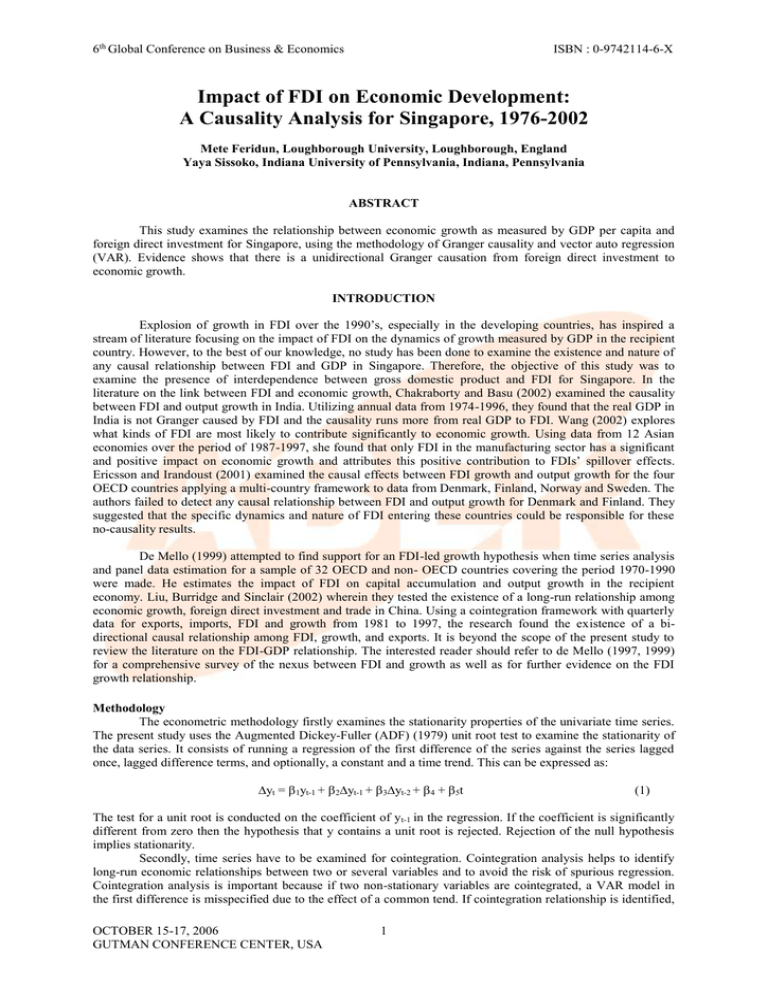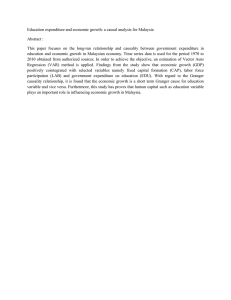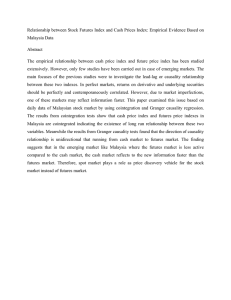Impact of FDI on Economic Development: A Causality Analysis for Singapore 1976-2002
advertisement

6th Global Conference on Business & Economics ISBN : 0-9742114-6-X Impact of FDI on Economic Development: A Causality Analysis for Singapore, 1976-2002 Mete Feridun, Loughborough University, Loughborough, England Yaya Sissoko, Indiana University of Pennsylvania, Indiana, Pennsylvania ABSTRACT This study examines the relationship between economic growth as measured by GDP per capita and foreign direct investment for Singapore, using the methodology of Granger causality and vector auto regression (VAR). Evidence shows that there is a unidirectional Granger causation from foreign direct investment to economic growth. INTRODUCTION Explosion of growth in FDI over the 1990’s, especially in the developing countries, has inspired a stream of literature focusing on the impact of FDI on the dynamics of growth measured by GDP in the recipient country. However, to the best of our knowledge, no study has been done to examine the existence and nature of any causal relationship between FDI and GDP in Singapore. Therefore, the objective of this study was to examine the presence of interdependence between gross domestic product and FDI for Singapore. In the literature on the link between FDI and economic growth, Chakraborty and Basu (2002) examined the causality between FDI and output growth in India. Utilizing annual data from 1974-1996, they found that the real GDP in India is not Granger caused by FDI and the causality runs more from real GDP to FDI. Wang (2002) explores what kinds of FDI are most likely to contribute significantly to economic growth. Using data from 12 Asian economies over the period of 1987-1997, she found that only FDI in the manufacturing sector has a significant and positive impact on economic growth and attributes this positive contribution to FDIs’ spillover effects. Ericsson and Irandoust (2001) examined the causal effects between FDI growth and output growth for the four OECD countries applying a multi-country framework to data from Denmark, Finland, Norway and Sweden. The authors failed to detect any causal relationship between FDI and output growth for Denmark and Finland. They suggested that the specific dynamics and nature of FDI entering these countries could be responsible for these no-causality results. De Mello (1999) attempted to find support for an FDI-led growth hypothesis when time series analysis and panel data estimation for a sample of 32 OECD and non- OECD countries covering the period 1970-1990 were made. He estimates the impact of FDI on capital accumulation and output growth in the recipient economy. Liu, Burridge and Sinclair (2002) wherein they tested the existence of a long-run relationship among economic growth, foreign direct investment and trade in China. Using a cointegration framework with quarterly data for exports, imports, FDI and growth from 1981 to 1997, the research found the existence of a bidirectional causal relationship among FDI, growth, and exports. It is beyond the scope of the present study to review the literature on the FDI-GDP relationship. The interested reader should refer to de Mello (1997, 1999) for a comprehensive survey of the nexus between FDI and growth as well as for further evidence on the FDI growth relationship. Methodology The econometric methodology firstly examines the stationarity properties of the univariate time series. The present study uses the Augmented Dickey-Fuller (ADF) (1979) unit root test to examine the stationarity of the data series. It consists of running a regression of the first difference of the series against the series lagged once, lagged difference terms, and optionally, a constant and a time trend. This can be expressed as: yt = 1yt-1 + 2yt-1 + 3yt-2 + 4 + 5t (1) The test for a unit root is conducted on the coefficient of yt-1 in the regression. If the coefficient is significantly different from zero then the hypothesis that y contains a unit root is rejected. Rejection of the null hypothesis implies stationarity. Secondly, time series have to be examined for cointegration. Cointegration analysis helps to identify long-run economic relationships between two or several variables and to avoid the risk of spurious regression. Cointegration analysis is important because if two non-stationary variables are cointegrated, a VAR model in the first difference is misspecified due to the effect of a common tend. If cointegration relationship is identified, OCTOBER 15-17, 2006 GUTMAN CONFERENCE CENTER, USA 1 6th Global Conference on Business & Economics ISBN : 0-9742114-6-X the model should include residuals from the vectors (lagged one period) in the dynamic Vector Error Correcting Mechanism (VECM) system. In this stage, Johansen (1988) cointegration test is used to identify cointegrating relationship among the variables. Within the Johansen multivariate cointegrating framework, the following system is estimated: Δzt = Г1 Δzt-1 + …+ Гk- 1 Δzt-k-1 + Пzt-1 + μ + εt; t =1, …,T (2) where, is the first difference operator, z denotes vector of variables, εt ~ niid (0,), μ is a drift parameter, and Π is a (p p) matrix of the form Π = αβ’, where α and β are both (p r) matrices of full rank, with β containing the r cointegrating relationships and α carrying the corresponding adjustment coefficients in each of the r vectors. The Johansen approach can be used to carry out Granger causality tests as well. In the Johansen framework the first step is the estimation of an unrestricted, closed pth order VAR in k variables. Johansen (1979) suggested two tests statistics to determine the cointegration rank. The first of these is known as the trace statistic N (3) where, are the estimated eigenvalues λ1 > λ2 > λ3 > … > λk and r0 ranges from 0 to k-1 depending upon the stage in the sequence. This is the relevant test statistic for the null hypothesis r r0 against the alternative r r0 . The second test statistic is the maximum eigenvalue test known as λmax; we denote it as λmax (r0). This is closely related to the trace statistic but arises from changing the alternative hypothesis from r r0to r r0The idea is to try and improve the power of the test by limiting the alternative to a cointegration rank which is just one more than under the null hypothesis. The λmax test statistic is: λ max (r0) = -T in(1 –λi) for i = r0 + 1 (4) The null hypothesis is there are r cointegrating vectors, against the alternative of r + 1 cointegrating vectors. Johansen and Juselius (1990) indicated that the trace test might lack the power relative to the maximum eigenvalue test. Based on the power of the test, the maximum eigenvalue test statistic is often preferred. According to Granger (1969), Y is said to “Granger-cause” X if and only if X is better predicted by using the past values of Y than by not doing so with the past values of X being used in either case. In short, if a scalar Y can help to forecast another scalar X, then we say that Y Granger-causes X. If Y causes X and X does not cause Y, it is said that unidirectional causality exists from Y to X. If Y does not cause X and X does not cause Y, then X and Y are statistically independent. If Y causes X and X causes Y, it is said that feedback exists between X and Y. Essentially, Granger’s definition of causality is framed in terms of predictability. To implement Granger test, we assume a particular autoregressive lag length k (or p) and estimate Equation (5) and (6) by OLS: k k i 1 j 1 p p i 1 j 1 X t 1 a1i X t i b1 j Yt j 1t Yt 2 a 2i X t i b2 j Yt j 2t (5) (6) F test is carried out for the null hypothesis of no Granger causality Ho: bi1 = bi2 = bik = 0, i = 1, 2 where, F statistic is the Wald statistic for the null hypothesis. If the F statistic is greater than a certain critical value for an F distribution, then we reject the null hypothesis that Y does not Granger-cause X (equation (1)), which means Y Granger-causes X. A time series with stable mean value and standard deviation is called a stationary series. If d differences have to be made to produce a stationary process, then it can be defined as integrated of order d. Engle and Granger (1987) state that if several variables are all I(d) series, their linear combination may be OCTOBER 15-17, 2006 GUTMAN CONFERENCE CENTER, USA 2 6th Global Conference on Business & Economics ISBN : 0-9742114-6-X cointegrated, that is, their linear combination may be stationary. Although the variables may drift away from equilibrium for a while, economic forces may be expected to act so as to restore equilibrium, thus, they tend to move together in the long run irrespective of short run dynamics. The definition of the Granger causality is based on the hypothesis that X and Y are stationary or I(0) time series. Therefore, we can not apply the fundamental Granger method for variables of I(1). In the absence of cointeragtion vector, with I(I) series, valid results in Granger causality testing are obtained by simply first differentiating the VAR model. With cointegration variables, Granger causality will further require inclusion of an error term in the stationary model in order to capture the short term deviations of series from their long-term equilibrium path. Hassapis et al. (1999) show that in the absence of cointegration, the direction of causality can be decided upon via standard Ftests in the first differenced VAR. the VAR in the first difference can be written as: k k i 1 j 1 p p i 1 j 1 N X t 1 a1i X t i b1 j Yt j 1t N Yt 2 a 2i X t i b2 j Yt j 2t . (7) (8) Results and Discussion The present study employs data that consists of annual observations spanning the period between 1977 and 2002. Table 1 shows the descriptive statistics of the data. All data are obtained from the World Bank WDI database and are transformed into logarithmic returns in order to achieve mean-reverting relationships, and to make econometric testing procedures valid. FDI is net inflows of investment to acquire a lasting management interest (10 percent or more of voting stock) in an enterprise operating in an economy other than that of the investor. It is the sum of equity capital, reinvestment of earnings, other long-term capital, and short-term capital as shown in the balance of payments. This series shows net inflows in the reporting economy. Data are in current U.S. dollars. GDP per capita, on the other hand, is gross domestic product divided by midyear population. GDP is the sum of gross value added by all resident producers in the economy plus any product taxes and minus any subsidies not included in the value of the products. It is calculated without making deductions for depreciation of fabricated assets or for depletion and degradation of natural resources. Data are in constant U.S. dollars. Table 2 shows the results of the ADF unit root tests on levels and in first differences of the data. Strong evidence emerges that all the time series are I(1). Table 3 presents results from the Johansen cointegration test among the data sets. Neither maximum eigenvalue nor trace tests rejects the null hypothesis of no cointegration at the 5% level. The outcome of the Granger causality tests is shown in Table 4. Results of Granger-causality test show the null hypotheses of FDI does not granger cause GDP per capita is rejected in 1 and 2 year lags, at the 5% and the 10% levels respectively. On the other hand, the null hypotheses of GDP does not granger cause FDI is not rejected. This leads us to the conclusion that there is only a one-way casualty running from FDI to GDP. Conclusion This study examines the relationship between foreign direct investment and GDP per capita in the economy of Singapore, using the methodology of Granger causality and vector auto regression (VAR). Strong Evidence emerges that the economic growth as measured by GDP in Singapore is Granger caused by the FDI. Results further suggest that Singapore’s capacity to progress on economic development will depend on the country’s performance in attracting foreign capital. REFERENCES Chakraborty, C. and Basu, P. (2002). Foreign Direct Investment and Growth in India: A Cointegration Approach. Applied Economics, 34, 1061-1073. De Mello, L.R. (1997). Foreign Direct Investment and Output: A Comparative Study, The International Trade Journal, 15, 221-311. De Mello, L.R. (1999). Foreign Direct Investment-Led Growth: Evidence from Time Series and Panel Data. Oxford Economic Papers, 51, 133-151. Dickey, D. A. and Fuller W. A. (1979). Distribution of the Estimators for Autoregressive Time Series with a Unit Root. Journal of the American Statistical Association, 74, 123-144. Engle, A. and Granger, C. (1987). Cointegration and Error Correction: Representation, Estimation and Testing. Econometrica, 55, 251-76. Ericsson, J. and Irandoust, M. (2001). On the Causality between Foreign Direct Investment and Output: A Comparative Study. The International Trade Journal, 15, 122-132. OCTOBER 15-17, 2006 GUTMAN CONFERENCE CENTER, USA 3 6th Global Conference on Business & Economics ISBN : 0-9742114-6-X Granger C. (1969). Investigating Casual Relationship by Econometric Models and Cross Spectral Methods. Econometrica, 37, 424-458. Hassapis, C., Pittis N., and Prodromidism, K. (1999). Unit Roots and Granger Causality in the EMS Interest Rates: The German Dominance Hypothesis Revisited. Journal of International Money and Finance, 18, 47-73. Johansen, S. (1988). Statistical Analysis of Cointegrating Vectors. Journal of Economic Dynamics and Control, 12: 231-54. Johansen, S. and Juselius, K. (1990). Maximum Likelihood Estimation and Inference on Cointegration with Applications for the Demand for Money. Oxford Bulletin of Economics and Statistics, 52, 169-210. Liu, X., Burridge, P., and Sinclair, P.J.N. (2002). Relationships between Economic Growth, Foreign Direct Investment and Trade: Evidence from China. Applied Economics, 34, 1433-1440. Wang, M. (2002). Manufacturing FDI and Economic Growth: Evidence from Asian Economies, Department of Economics, University of Oregon Mimeo. Table 1. Descriptive Statistics GDP UN IM Mean 1.545022 13.00718 7.961727 Median 2.215338 13.098 9.213 Maximum 4.932729 18.426 11.1 Minimum -2.67133 3.552 1.998 Std. Dev. 2.813073 4.631725 3.15993 Skewness -0.55246 -0.74475 -0.79574 Kurtosis 1.924972 2.937192 2.388918 Jarque-Bera 1.319233 0.979797 1.411518 Probability 0.612694 0.713916 0.587747 Sum Sq. Dev. 71.29173 193.2692 89.95642 Table 2. Augmented Dickey-Fuller Unit Root Test Results Test with an intercept Levels Test with an intercept and trend Test with no intercept or trend 1st differences 1st differences Levels Levels 1st differences IM 2.498277 -10.8764 1.345764 -6.70895 1.135974 -7.38527 GDP 2.590962 -7.4864 0.506604 -12.9129 3.047283 -10.4731 UN 1.12776 -9.29381 1.036407 -8.18059 1.369851 -4.78721 CV* (1%) -4.2816 -4.35153 -5.07437 -5.18126 -2.99667 -3.01643 CV (5%) -3.37473 -3.40271 -4.09679 -4.14363 -2.17715 -2.18048 * McKinnon Critical Value The lag length was determined using Schwartz Information Criteria (SIC) Table 3. Johansen Cointegration Test Results Null hypothesis Trace statistic OCTOBER 15-17, 2006 GUTMAN CONFERENCE CENTER, USA Maximum eigenvalue statistic 5% critical value 4 5% critical value 6th Global Conference on Business & Economics ISBN : 0-9742114-6-X r=0 32.7112 40.44 20.7220 28.6228 r<=1 12.568 23.93 9.7811 22.3411 r is the number of cointegrating vectors under the null hypothesis. Table 4. Granger Causality Test Results F - Statistics Null hypothesis Lag 1 Lag 2 Lag 3 Lag 4 FDI does not granger cause GDP per capita 10.4221** 6.1223* 0.0021 0.5225 GDP per capita does not granger cause FDI 0.142271 0.9212 1.8272 0.3996 * Reject the null hypothesis at the 10% level. ** Reject the null hypothesis at the 5% level. *** Reject the null hypothesis at the 1% level. OCTOBER 15-17, 2006 GUTMAN CONFERENCE CENTER, USA 5




